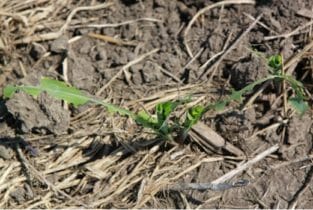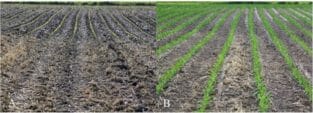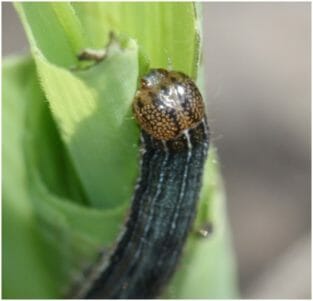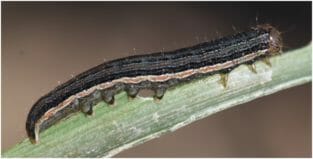True armyworm, cereal rye cover, and no-till: an unfortunate combination in 2015
Guest blog by Adam J. Varenhorst, Mike W. Dunbar, Erin W. Hodgson

Figure 1. TAW larvae feeding on the leaves of corn. Larvae will not consume the tough midrib of the leaves. Photo courtesy of Adam J. Varenhorst.
Biology
The true armyworm (TAW) is an occasional, early-season pest of corn that has the potential to reduce corn yields. TAW cannot overwinter in Iowa, and each year adult moths rapidly migrate northward from Gulf-coast states throughout April and May. Migrating TAW moths are attracted to living ground cover, which can include field margins, fields with grassy weeds, or fields with small-grain cover crops such as cereal rye. Upon arrival, the female moth will lay eggs onto the living ground cover. After hatching, young TAW larvae will feed on the living cover (weeds, small-grains, or the current crop) until they complete their development. There are as many as three generations of TAW per year in Iowa, however, only the first generation has the potential to reduce corn yields.
Injury
Injury from TAW occurs from larvae feeding on the leaf tissue of early and late vegetative corn. Feeding by larvae on corn plants typically begins on the lower leaves and as leaf tissue is removed the larvae will move to the upper leaves (Fig. 1). Defoliation caused by TAW is limited to the leaf tissue excluding the tough midrib; larvae do not tunnel into the stalk and on larger plants do not feed on the growing point.
Fields at risk
Fields at greater risk of TAW injury include those that are minimum or no tilled, or contained a small grain cover crops including cereal rye. Injury to corn by TAW is typically observed when the living cover is removed, either by tillage or herbicide, at which point the larvae will move to corn and begin feeding.

Figure 2. A comparison of a TAW injured cornfield pre- and post-management. (A) Corn seedlings with TAW infestation before management, and (B) corn two weeks post management. Photo courtesy of Adam J. Varenhorst.
Management
- Fields that are minimum or no tilled, or fields that had a cover crop should be scouted for TAW in May and June (through V8). Larvae can generally be found in the whorl of the corn plant.
- For corn seedlings (VE – V2) it is recommended that treatment occur if 10% or more of the seedlings corn plants are injured and larvae that are less than ¾ inch in length are still present.
- For corn that is in the 7-8 leaf stage (V7 – V8), treatment of TAW should be considered when larvae are less than ¾ of an inch long, there are more than eight larvae per plant, and 25% of the leaf area has been removed.
Larvae that are less than ¾ inch in length will feed for another week, and may cause additional injury. Appropriate management of TAW can prevent yield loss, as young corn plants will quickly recover from defoliation (Fig. 2).

Figure 3. TAW larvae can be identified by a network of dark lines on their head capsule. Photo courtesy of Adam J. Varenhorst.
Identification
TAW are identified by a network of black lines present on their orange head capsule (Fig. 3).
In addition, TAW larvae can also be identified by the dull orange stripes found on each side of their body (Fig. 4). TAW larvae have six legs found on the thorax, they also have four prolegs on their abdomen marked with dark bands (Fig. 4). General body color of TAW larvae can vary seasonally and should not solely be used for identification.

Figure 4. TAW can also be identified by the orange stripe that is found on each side of their body, and the four prolegs on their abdomen that are marked with dark bands.
Adam Varenhorst is an entomology postdoctoral research associate. Mike Dunbar is an entomology Ph.D. candidate. Erin Hodgson is an assistant professor of entomology with extension and research responsibilities; contact at ewh@iastate.edu or phone 515-294-2847.
